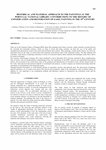 |
C. M. Soares, R. M. Rodrigues, A. J. Cruz, C. Rego, "Historical and material approach to the paintings at the Portugal National Library: contributions to the history of conservation and restoration of easel painting in the 19th century", International Journal of Heritage in the Digital Era, 1(S1), 2012, pp. 283-288, doi:10.1260/2047-4970.1.0.283 |
| Abstract |
There are in the National Library of Portugal (BNP) about fifty paintings from former convents, mainly portraits executed between the sixteenth and nineteenth centuries, which are hung in rooms and along corridors, far from the eyes of the public and simultaneously protected by recent conservation and restoration interventions. These paintings, of little artistic interest, are, however, individual cases for the study of conservation and restoration interventions made in the nineteenth century. The data obtained will contribute to the history of paintings restoration, in terms of its practical aspects (about materials and techniques used), that is still to be written in Portugal.Our research, which began in January 2011 and is predicted to end in December 2013, has been oriented by three complementary lines of action, with an interdisciplinary methodological base: the exploitation of the BNP's precious and unpublished documental archive; the assessment to the conservation status of the paintings and identification of restoration works; and the material study of the works, from physical and chemical methods of examination and analysis, in order to deepen our technical knowledge about the restoration of easel painting in the nineteenth century.Through historical documents we could identify periods of restoration, restorers and materials used. The observation of paintings allowed selecting a set of twenty-seven pieces that showed old restorations, made in the nineteenth or early twentieth century. In addition it's very important to use examination methods and laboratory analysis to characterise the restoration works and the materials used. |
